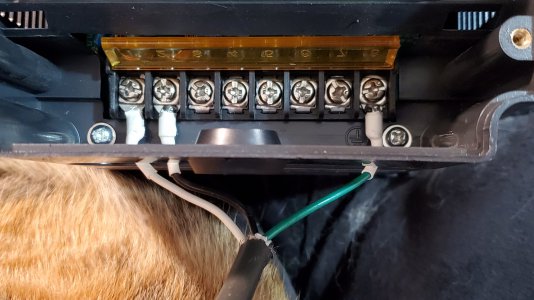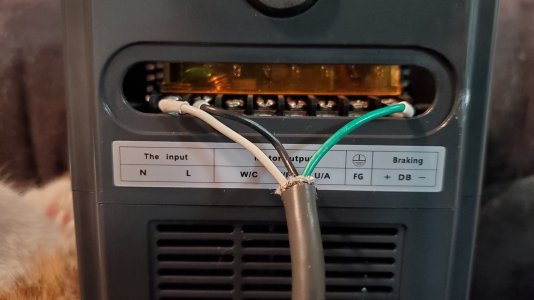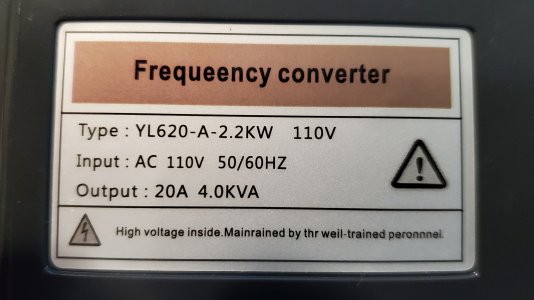- Joined
- Feb 24, 2019
- Messages
- 924
I almost posted this in the CNC forum.
Long story short, I'm building a CNC machine.
I'm putting together the structure some days, working on electric/electronic components other days and then working on other stuff other days and so on.
I bought a Chinese inverter. Model #VL620-A. I bought a 110V model for the 2.2KW spindle. It was all part of a package.
I looked at the book but I'm too freakin old to read 3 point type. I ended up looking at a couple youtube videos.
They all showed the wiring the same way. Neutral to the far left. Earth ground to the far right. Second from the left is line voltage.
I took a computer cord and stripped off the end and cleared the insulation on the three wires. I soldered connectors to the wire and then insulated them with shrink tube.
Green is obviously earth ground.
White is usually common/neutral
Black is traditionally line
That's how I hooked everything up.
This is where stuff got weird.
I plugged it in in my living room. It POPPED. Then my TV and all my other components went off. But the inverter stayed on, with the display blinking in an error state. I didn't think to check the error.
The weird thing is that the breaker for my TV popped but the outlet I plugged the inverter into was still live.
This shouldn't be possible, I don't think.
Is it possible I have the inverter wired backwards and I, somehow, fed enough voltage back through the neutral to overload the TV breaker?
I do plan on using a continuity tester to make sure the power cord white is, indeed, the neutral. If the black and white are swapped in there then that would probably cause issues.
I also detected magic smoke from the pop. I sniffed inside the inverter and it doesn't smell like magic smoke. I can't imagine I did any damage inside it.
Any ideas?
Long story short, I'm building a CNC machine.
I'm putting together the structure some days, working on electric/electronic components other days and then working on other stuff other days and so on.
I bought a Chinese inverter. Model #VL620-A. I bought a 110V model for the 2.2KW spindle. It was all part of a package.
I looked at the book but I'm too freakin old to read 3 point type. I ended up looking at a couple youtube videos.
They all showed the wiring the same way. Neutral to the far left. Earth ground to the far right. Second from the left is line voltage.
I took a computer cord and stripped off the end and cleared the insulation on the three wires. I soldered connectors to the wire and then insulated them with shrink tube.
Green is obviously earth ground.
White is usually common/neutral
Black is traditionally line
That's how I hooked everything up.
This is where stuff got weird.
I plugged it in in my living room. It POPPED. Then my TV and all my other components went off. But the inverter stayed on, with the display blinking in an error state. I didn't think to check the error.
The weird thing is that the breaker for my TV popped but the outlet I plugged the inverter into was still live.
This shouldn't be possible, I don't think.
Is it possible I have the inverter wired backwards and I, somehow, fed enough voltage back through the neutral to overload the TV breaker?
I do plan on using a continuity tester to make sure the power cord white is, indeed, the neutral. If the black and white are swapped in there then that would probably cause issues.
I also detected magic smoke from the pop. I sniffed inside the inverter and it doesn't smell like magic smoke. I can't imagine I did any damage inside it.
Any ideas?





